Planing is the process of removing layers of metal from flat surfaces of workpieces. It is used along with milling, but differs in a different kinematics of the movement of the working tool: if the cutter performs a rotational movement, then the cutter on the planer is reciprocating. On such equipment, grooves and grooves are sometimes also performed.
Varieties
A planer for metal can be a longitudinal planer or a cross planer. The principle of processing blanks on these varieties is fundamentally different. Longitudinal planers are designed for processing relatively short surfaces, therefore, in them, the movement receives a table to which the workpiece is attached, while the cutter is installed in the cutter head of the caliper and does not move relative to the machine bed. In a cross-cutting machine, the opposite is true: the cutter moves, and the semi-finished product installed on the table is motionless.
Planers lose out to milling machines in productivity because they have an idle stage when the workpiece or cutter is moved to a new position. But the drive is not so energy-intensive, because. rotational movement of the working tool (as in milling machines) requires increased work costs from the drive motor.
Classification of the considered metal cutting equipment can be made in other ways:
- Drive type. Units are produced with a hydraulic drive of the table (or tool), as well as with a crank-rocker version of the drive. For the former, the speeds of the moving units are constant, while for the latter, they can change according to the characteristics of the processing technology. To do this, it is enough to reinstall the stone of the rocker mechanism in a new position.
- By the number of work surfaces that can be processed simultaneously. Four-sided planers for metal can process simultaneously on all sides of the semi-finished product, while double-sided - only from opposite sides. Accordingly, the caliper of machine tools of the first variety has more complex structure and is intended for four incisors. Single-sided machines are mostly small-sized.
- Drive power. Small-sized machines are limited in their functionality, but attract the consumer at a small price and compactness, so they can be installed in small metalworking industries, or even in private workshops.
- According to the tool or table movement configuration. For complex trajectories, metal planing machines are produced, which are equipped with a CNC system. They are used in small-scale production, if it is necessary to obtain complex flat surfaces on products. In this case, the qualification of the worker does not matter much, since all movements are carried out according to the coordinates entered in advance into the memory of the system.
Device
For the qualitative performance of the functions assigned to it, planing machines must include the following components:
- bed;
- caliper with one or more toolholders;
- frame (on large machines, the frame has a portal configuration, on smaller ones it is made in the form of a console);
- mechanism for moving the table and / or support;
- work table with T-slots for precise positioning of the product;
- electric motor;
- a pumping station for supplying lubricating-cooling media to the planing zone;
- crossbars connecting the elements of the frame and giving it the necessary rigidity;
- control unit.
For working movements of the cutter in longitudinal planers, a crank-rocker drive is used. Numerous options for its settings allow you to perform operations with metal on vertical, horizontal and even inclined planes.
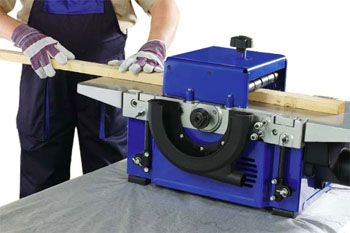
The change in the speed of movement of moving parts is made by a gearbox in which there is a set of several gear pairs. By including (manually or according to the program) a certain pair of work, a new speed of movement of the workpiece or tool is obtained. The choice depends on the mechanical characteristics of the metal being processed. For less ductile materials, power cutting is used with increased feed rates, and ductile workpieces are planed at reduced speeds to prevent chips from sticking to the cutter, reduce friction losses and reduce thermal deformation of the workpiece.
Nomenclature and designation
All standard sizes of planing equipment are included in the group of machines for processing flat surfaces. At the same time, general-purpose machines (both cross- and longitudinal-planing), specialized and special are marked separately.
The general classification index for such equipment includes an alphanumeric designation of the type XXXX. The first index - a number - determines the assignment of the machine to a particular type. For the equipment in question, this is always the number 7. This is followed by a number that indicates the type of machine:
- 1 - single-column longitudinally planing;
- 2 - two-column longitudinally planing;
- 3 - cross-planing;
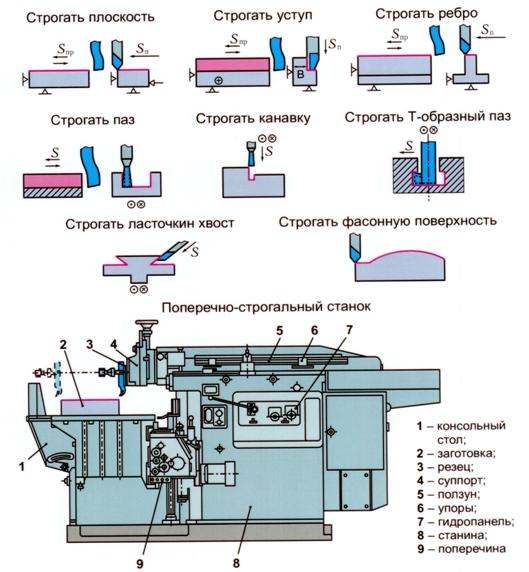
The last two digits of the marking indicate the main technological parameter of the equipment. As a rule, this is the largest dimension of the workpiece in decimeters. For example, brand 7310 will indicate that this unit is cross-planing, and is designed for metal processing with a maximum plane length of up to 1000 mm. The letter in the designation (for example, 7A110) indicates a modification of the basic model (for example, the presence of a hydraulic drive, an additional clamping unit, etc.). The presence of the letter F in the designation indicates that this equipment is equipped with a CNC system.
If you find an error, please highlight a piece of text and click Ctrl+Enter.
In modern industry, various planers for wood are presented. In this article we will consider the main and popular types of machine tools.
The main components of the machine with a crank-rocker mechanism and their purpose
The main guide unit of the cross planer is a frame equipped with horizontal guides that provide longitudinal movement of the slider equipped with a caliper. The vertical guides of the bed provide movement of the crossbars along which the table, equipped with a stand, moves to ensure greater stability. The element to be machined is fixed on the horizontal and vertical supporting surfaces of the table in T-slots specially designed for this purpose, while the cutter is mounted in a special tool holder mounted on the support.
The main rectilinear reciprocating motion is transmitted to a slider equipped with a cutter, while when planing horizontal surfaces, the feed motion is reported to the workpiece, moving along with the table along the guide rails. To carry out planing of vertical and inclined surfaces, the feed is performed by moving the caliper along the vertical guides.
In addition, the vertical feed of the caliper can be performed by moving the cross member vertically along the bed rails. However, in most cases, this movement is used exclusively in the form of an installation in the process of setting up in accordance with the dimensions of the workpiece being processed. Manual vertical movement of the support is also used when planing horizontal surfaces in order to set the cutter to the depth of cut during the setting process, as well as during repeated passes.
The design of the cross planer
The frame of the cross planer structurally consists of a box-shaped cast iron body mounted on a slab attached to the foundation by means of fixing bolts. The high level of rigidity and strength of the machine bed is achieved due to internal stiffening ribs, while the upper part of the bed is equipped with flat horizontal guides, to which strips are attached by means of screws, creating guides in the form of a dovetail. In turn, the "dovetail" ensures the movement of the slider with a tight fit of this device by adjusting one of the guide bars with screws on the side wall of the frame.
The front wall of the bed is equipped with flat guides that provide vertical movement of the crossbar that secures the table. Inside, the machine bed is equipped with a gearbox and a rocker mechanism, the installation and monitoring of which is carried out through special holes and hatches, with covers mounted in the stacks of the bed. The back wall of the bed is equipped with a special bracket that provides installation of the machine's electric motor, while there is a special tray on the back wall of the bed to drain the oil flowing from the slider guides.
Mechanisms of the main working movement
Planer for wood (in particular, cross- planer) operates from an electric motor that transmits, by means of a worm gear, the rotation of a six-speed gearbox, the shaft of which is equipped with a sliding key that secures a triple block of gears, providing the shaft with three speeds. Thus, when the block is moved along the axis of the shaft, the gears are alternately engaged with the gears fixed on the key on the shaft. As a result, the shaft has six speeds.
2. Planer
The main components of longitudinal planers and their purpose
Wood planers, and in particular longitudinal planing modifications, have a table, a bed and a traverse as the main unit. The travesty of the machine provides vertical movement of the two calipers, while the vertical guides of the bed provide movement of the side caliper. The main working movement is provided by the electric motor of the equipment through a worm-and-rack gear to the table, while the feed movement is provided by the calipers.
The movement of the calipers along the guides of the traverse and bed is provided by separate electric motors designed to carry out this particular operation. All supports of this equipment are structurally equipped with a device that provides the fastest possible movement, and are also structurally adapted to provide automatic lifting of the cutter at the end of the working stroke. In addition, the traverse of the machine is characterized by accelerated movement up and down the bed due to the electric motor. For control, all planers for wood, in this case a planer, are equipped with a special remote control mounted on a flexible hose and thereby ensuring the location of the device in any place convenient for the operator.
General characteristics of the two-column longitudinal planer brand 7212
This planer includes the following devices:
- bed,
- table moving along the horizontal guides of the frame,
- crossbars moving along the vertical guides of the racks,
- upper calipers rigidly connected to the frame and the upper beam of the portal,
- drive unit and gearbox,
- side caliper gearbox,
- control panel for machine control,
- pendant push station.
The drive and feed control of planer calipers are provided by a gearbox, while the control of vertical calipers is duplicated at both ends of the crossbar.
Planer knife sharpening
To ensure efficient operation, wood planers provide for periodic sharpening of knives, which can be done independently, subject to certain requirements. First of all, you should set the required sharpening angle and only after that start work. Fixed removal of metal from the knife being sharpened is provided by a stop equipped with two sliders with a division scale of 0.1 mm, thus providing adjustment of the amount of removal in exactly the specified proportions.
Sharpening of the knife is provided by moving the holder with the knife to the right and left relative to the grinding stone. In order to avoid vibrations of the fence during sharpening, after each feed, it is imperative to securely fix the fence with the two clamping screws. In addition, during sharpening, it is necessary to avoid the knife being sharpened beyond the limits of the grinding stone, taking into account the stop of the holder at a distance of 12 mm from the edge of the grinding wheel. To eliminate this phenomenon, there are special adjustable stops that provide the ability to set the required stroke of the holder.
Knife sharpening process
It should be especially noted that during sharpening planer knife accumulation and distribution of water on the blade from the grinding stone is formed, subsequently flowing onto the body grinding machine and, accordingly, on the floor. Water is consumed in in large numbers and requires regular addition to a special container. To reduce the amount of spilled water on the body of the grinding machine, you can put a lining 5–6 mm high under its right leg and thereby slightly reduce the amount of water falling on the body. This measure does not completely exclude water from entering the machine body, although in most cases they are reliably protected and not exposed to water.
Another problem when sharpening a planer knife is that the SG 250 stone tends to be constantly clogged and thus significantly reduce the level of sharpening efficiency, as well as increase the sharpening time. As a result, it is necessary to constantly clean the grinding wheel with a special bar of the SP-650 brand to clean and level the surface of the grinding wheel. In addition, the sharpening process to a large extent depends on the quality of the metal of the planer knife.
For example, a knife made of HSS steel simply “kills” the SG 250 grinding wheel, which is more than effective for sharpening planer knives from mild tool steel. The best option for sharpening planer knives made of HSS steel is the SB-250 grinding wheels, which provide high-quality sharpening of the planer knife for no more than 20 minutes, resulting in a smooth, beautiful bevel of the blade with a consistently even burr of the cutting edge. After that, the knife is finished with a special leather circle using a paste for finishing and polishing brand RA-70.
Planers for wood
Four-sided planers for wood provide simultaneous planing of the material in one pass from all sides, ensuring planing along the shaped profile, thereby ensuring the manufacture of comb, tongue, molding and front part in the form of skirting boards, platbands and cornices in one pass. In fact, the four-sided planer combines a planer, planer and milling machine in its design, and also has a lower and upper horizontal knife shaft with straight knives and two even vertical spindles.
 Spindles are used for mounting cutter heads, milling cutters, as well as cartridges equipped with shaped knives. The vertical spindles and the lower cutterbar are attached to the frame and work plate, while the upper cutterbar moves vertically, thereby ensuring that the planing thickness of the workpiece is set to the desired thickness. The spindles move in the horizontal and vertical direction relative to the thickness and width of the workpiece being made. Wood planers are characterized by high level productivity, durability and cost-effectiveness while ensuring the highest quality manufactured products that meet all international quality standards.
Spindles are used for mounting cutter heads, milling cutters, as well as cartridges equipped with shaped knives. The vertical spindles and the lower cutterbar are attached to the frame and work plate, while the upper cutterbar moves vertically, thereby ensuring that the planing thickness of the workpiece is set to the desired thickness. The spindles move in the horizontal and vertical direction relative to the thickness and width of the workpiece being made. Wood planers are characterized by high level productivity, durability and cost-effectiveness while ensuring the highest quality manufactured products that meet all international quality standards.
Combined planer for wood, video review

Even selected moldings have a certain percentage of error in the geometry of the planes. But the cost of ordering fine finishing is justified only in the case of one or two boards or timber. Therefore, the calibration of large quantities of lumber must be carried out directly at the place of its use. See our rating of thicknessing machines (RS) and you will be able to evaluate the equipment for cost-effective operation of the carpentry workshop.
| Criterias of choice | Area of Criteria Responsibility |
|---|---|
| Power | A PC with a collector motor consuming up to 1.6 kW works effectively only in a gentle mode. Needs periodic rest. The motor is sensitive to high temperatures. For personal use. |
| Processing of blanks on machines with engines more powerful than 1.6 kW is possible with a more significant load. It is allowed to remove the maximum possible layer from a narrow workpiece. High-quality processing of a wide board (even for a 2.2 kW motor) is possible only with minimal planing. A thicknesser with such characteristics is suitable for intensive work. Most models are operated for commercial purposes. | |
| Permissible workpiece dimensions | Describe the range of workpiece sizes that can be processed on the PC. This factor should be taken into account for the correct choice of woodworking equipment, depending on the available lumber size. |
| Planing depth in one pass | The limit of possibilities for the working elements of the planer shaft is in the range of 2-3 mm. It is possible to work with such indicators without excessive load on the engine and gearboxes only with narrow workpieces. |
| By adhering to the depth (1-1.5 mm) recommended by the manufacturer, you can count on a quality result - both with hard rocks and with relatively wet (more than 20%) material. | |
| Thickness table length | The working surface with a length of more than 500 mm allows you to comfortably process meter-long workpieces. And from a 771 mm table (Makita 2012 NB), even a 1.5 meter board will not fall. |
| The stable 255 mm table (Encor Corvette 24) guarantees a quality result only with material of the same length. It is not always convenient to load longer parts into the thickness gauge correctly. And after exiting from under the planing shaft, they will move down. Which will lead to the formation of drops ("steps") at the ends of the workpiece. | |
| Weight | Helps to match the user's ability to install, move or transport the thicknesser. So the weight of the machine within 30 kg allows you to work on stable table, in any convenient place. Models in the range from 40 to 50 kg are also quite mobile, but most often they are installed on mobile or stationary stands of various modifications. Machines weighing over 60 kg - stationary option. |
| Design features | - Steel frame and cast base - provide structural strength. - Planer table - allows you to pre-align the geometry of the workpiece. - Four guide racks - hold the movable platform of the surface gage in a horizontal position. - Thermal protection - monitors the condition of the engine. - Magnetic starter - prevents the machine from turning on after the appearance of voltage in the network. - Compression springs - reduce the amplitude of the backlash of moving elements. |
| Torque transmission method | The rotation is transmitted to the planing shaft by means of a gear reducer (even the minimum free play of parts is excluded). The automatic feeding system of the workpiece can be equipped as a belt ( low level noise, minimum load on the drive), and chain (wear-resistant, reliable gearbox) transmission. |
| Availability of consumables and spare parts | The profitability of the equipment under any operating conditions is possible only with free access to spare parts and the presence of a local service department. |
As for the number of knives on the cutterhead, well-known models have two in the basic configuration. But they can be maintenance-free, resharpenable and (as a subspecies) reversible. And only stationary heavy machines can have three or four knives on each of the working elements. The option with the selection of a non-standard shaft, again, takes place only in the case of powerful equipment. And the collector motors of popular thicknessing machines do not have sufficient potential to work with non-standard consumables (3, 4-knife, screw shafts or multi-knife "corn") with decent efficiency. Even though last option proved its worth when used on industrial thicknessers and jointers.
Don't miss the fundamental difference between similar processes
Several passes of piece lumber with broken geometry along the planer table allow you to get a right angle of adjacent surfaces of the workpiece. And the resulting planes will be used as a base for further calibration. That is, by passing profiled lumber through a thicknessing machine, you get perfectly flat parallel surfaces and a right angle along the entire length of the board or beam.
The interchangeability of these processing steps is excluded:
- The thickness gauge does not correct the overall geometry of the part (there is no stop perpendicular to the desktop, the board is held by pressure rollers);
- The potential of the jointer only allows you to correct all kinds of "propellers", "sabers", "skis" and other variants of molding deformation. By removing only the protruding parts of the adjacent planes of the curved board, you get an acceptable workpiece for subsequent calibration on a thicknesser. Preliminary jointing of a curved board (beam) from all sides, allows subsequently to reduce the load on the pressure rollers of the thicknesser. Thus increasing the operational potential of expensive equipment.
| Model | power, kWt | Maximum allowable dimensions of the workpiece (H-height, B-width), mm | Depth of planing (max / working), mm | price, rub. |
|---|---|---|---|---|
| Budget models for non-intensive use | ||||
| 1.25 | H-5-120, B-204 | 2 / 1 | 18200 | |
| 2.0 | H-6-160, B-330 | 3 / 1.5 | 20990 | |
| 1.5 | H-13-152 / B-19-330 | 2.8 / 0.8 | 25389 | |
| Thicknessing machines in a creative workshop | ||||
| 1.8 | H-5-153, B-318 | 2.5 / 1 | 26000 | |
| 1.5 | H-5-153, B-318 | 3 / 1.5 | 26500 | |
| 1.5 | H-120, B-254 | 3 / 1 | 31500 | |
| 1.8 | H-3.2-152.4, B-330 | 2.4 / 1 | 35390 | |
| Precision equipment for a small commercial carpentry shop | ||||
| 1.65 | H-155, B-304 | 3 / 1 | 40590 | |
| 1.8 | H-152, B-317 | 2 / 1 | 52243 | |
| 2.2 | H-160, B-260 | 3 / 1 | 73999 | |
1. Encore Corvette 24 - 18200 rubles.
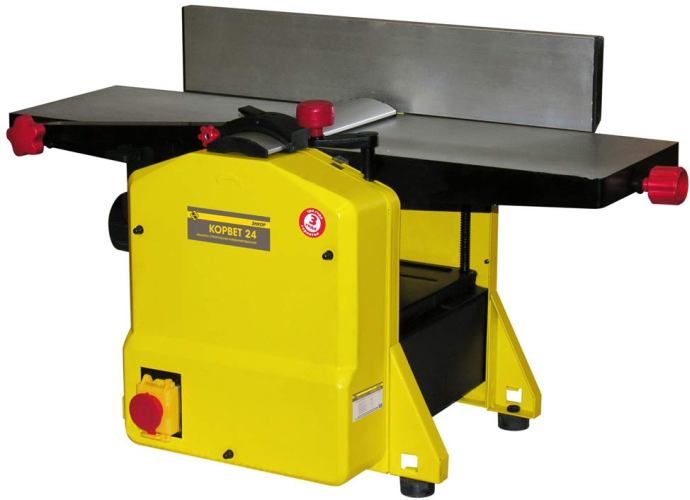
The universal model is designed for non-intensive sizing of lumber. The layout of the equipment allows you to perform rough planing, jointing at different angles and thicknessing of the workpiece. The machine is equipped with a magnetic starter and motor thermal protection. The operating potential is designed for use in a home workshop.
In fact, the Encore Corvette 24 is a budget analogue of the JET JPT 10b model. As evidenced by a similar scheme of the device, the identical design of the gearbox of the automatic workpiece feeding system, and the arrangement of the elements of the planing block. There are minor differences in appearance, and some dimensions of these thicknessing machines. In addition, the Corvette compares favorably in terms of cost.
The owner will also be pleased with the speed of drawing the workpiece (with the same working depth of planing of 1 mm, the Corvette claims 9000 rpm, and the JET produces no more than 6000 rpm). This contributes to a significant reduction in labor costs.
| Specifications | Values |
|---|---|
| power, kWt | 1.25 |
| 8000 | |
| Automatic workpiece feed speed, m/min | 8 |
| 2 / 1 | |
| H-5-120 / B-204 | |
| 255 (737) | |
| Design features | Magnetic starter, belt drive, motor thermal protection |
| Add. equipment | Pusher, chip guard, hex wrench |
| Weight, kg | 26 |
| Development / production | Russia / China |
| Cost, rub. | 18200 |
Watch a full video review, revealing the design and control features of the Enkor Corvette 24 machine:
2. Special SRM-2000 - 20990 rubles.
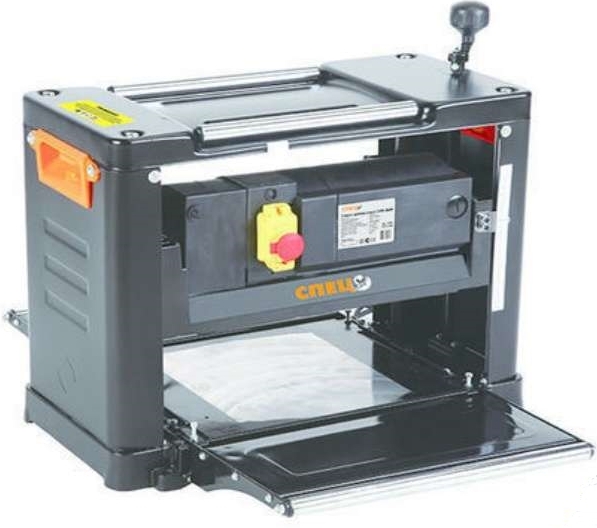
Assembled on a cast base, the frame structure of the CPM-2000 body provides the machine with sufficient rigidity. Which is useful for effective sizing of timber, edged and unedged board, up to 330 mm wide. The height of the workpiece can be in the range of 6-160 mm. The minimum length of lumber is limited by the distance between the edges of the rubberized rollers. The maximum score is not limited. That is, this equipment is able to satisfy any needs of the user in the construction, repair and decoration of residential and auxiliary premises.
The transmission of torque to the working shaft from a powerful commutator motor is carried out by means of a belt drive. Due to this, the noise level and the likelihood of damage to the power unit are reduced with an increase in load in excess of the calculated values. Auxiliary rollers on the edges of the table enlargers and the upper surface of the machine, simplify the work with long lengths. Responsible for operational safety automatic protection from overloads and a block that prevents the equipment from turning on after a drop in mains voltage.
| Specifications | Values |
|---|---|
| power, kWt | 2.0 |
| Shaft speed, rpm | 8000 |
| 8 | |
| Depth of planing (maximum / working), mm | 3 / 1.5 |
| H-6-160 / B-330 | |
| Thickness table length, mm | 350 |
| Design features | Cast steel frame, planing depth adjustment knob, auxiliary rollers for easier workpiece feeding |
| Add. equipment | Exhaust spigot, blade template, assembly tools |
| Weight, kg | 31 |
| Development / production | Russia / China |
| Cost, rub. | 20990 |
Watch the video review of Spec CRM 2000:
3. Interskol RS 330 1500 - 25400 rubles.
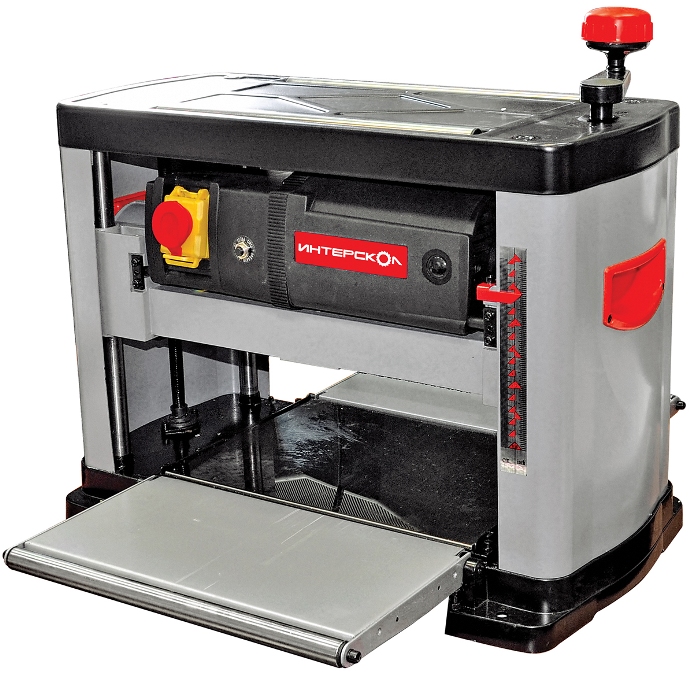
One of the few successful low-cost developments. It is distinguished not only by an acceptable cost, but also by an impressive working potential (the thermal protection relay is responsible for the duration of the collector motor). The security system is also at the proper level (the power button is hidden under a hinged cover, the shutdown key is duplicated by a wide “mushroom” placed behind the protective cover).
The budget model is for personal use only. And in the absence of excessive load (the source of which may be a material with natural moisture), the owner will be pleased. Differs in low (for the chain drive of shaft) noise level. Automatic broach allows you to count on a decent result of thicknessing wood of any species.
The quality level of processing is achieved not only due to the high speed of the cutterhead with two carbide knives. The organization of chip removal from the workspace is also important. Why the machine package includes a plastic catcher case and an adapter for connecting a vacuum cleaner.
| Specifications | Values |
|---|---|
| power, kWt | 1.5 |
| Shaft speed, rpm | 9000 |
| Automatic feeding speed of the workpiece, m/min | 7 |
| Depth of planing (maximum / working), mm | 2.8 / 0.8 |
| Limit dimensions of the workpiece (H-height / B-width), mm | H-13-152 / B-19-330 |
| Thickness table length, mm | 350 |
| Design features | Automatic feed with chain reducer, thermal protection relay, upper passive rollers for moving long lengths |
| Add. equipment | Blade setting template, chip guard, set of necessary keys |
| Weight, kg | 33 |
| Development / production | Russia / China |
| Cost, rub. | 25400 |
Watch a short video review that reveals the working potential of the Interskol RS 330 1500 machine:
4. JET JWP 12 - 26,000 rubles.
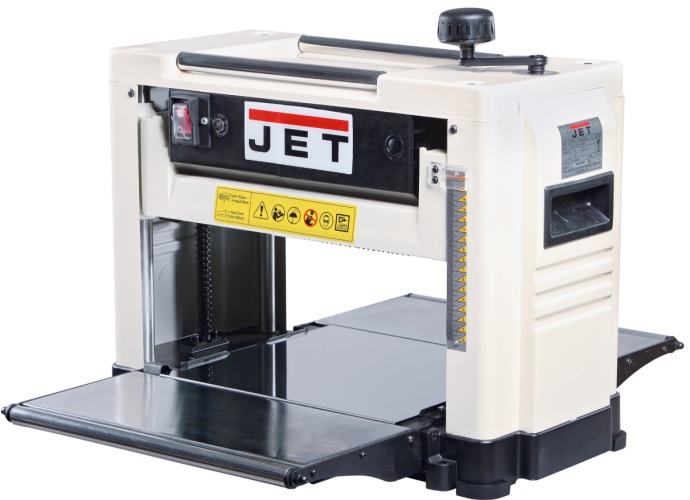
This portable hobby machine attracts attention because of the ratio of light commutator motor power, automatic feed speed and high speed cutterhead.
The system of removal of shaving is thought over. Top quality and workmanship folding tables(with longitudinal rollers). The JET JWP 12 protective system consists of a “claw” protection that catches the workpiece during a reverse impact and a thermal relay unit (with a forced activation key).
The machine is widely demanded by artisan carpenters to perform tasks requiring high precision. And only the ever-present need to clean all the sinuses of the machine from chips does not allow us to classify JET JWP 12 as a specialized professional equipment.
| Specifications | Values |
|---|---|
| power, kWt | 1.8 |
| Shaft speed, rpm | 9000 |
| Automatic feeding speed of the workpiece, m/min | 7 |
| Depth of planing (maximum / working), mm | 2.5 / 1 |
| Limit dimensions of the workpiece (H-height / B-width), mm | H-153, B-318 |
| Thickness table length (with additional tables), mm | 295 (690) |
| Design features | Motor thermal protection, automatic workpiece feed |
| Add. equipment | Additional (feeding, unloading) tables, plastic dust cover, adapter for chip removal, set of keys |
| Weight, kg | 27 |
| Development / production | Switzerland / Switzerland, China |
| Cost, rub. | 26000 |
Watch a video review describing the design and operation features of the JET JWP 12:
5. Kraton WMT 318 - 26500 rubles.
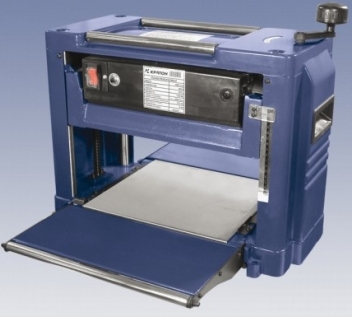
A simple and popular thicknessing machine is assembled on a rigid frame frame. That with a relatively modest size and not the most big weight, is a significant factor. Determining the accuracy and reliability of equipment for a small workshop. Get this model and for work on the road.
The launch is performed by a key located under the protective cap. Nearby is the button for activating the thermostatic unit. The movable planer located above the work table moves (in a vertical plane). Precise control is carried out by a handle located on top.
One of the key features that distinguishes this model is dynamic braking, a process that reduces the “free coast” (coasting) time of the motor. Folding extensions and automatic feeding of the workpiece under the planing shaft greatly simplify the work with long sawn timber.
| Specifications | Values |
|---|---|
| power, kWt | 1.5 |
| Shaft speed, rpm | 8 |
| Automatic feeding speed of the workpiece, m/min | 8 |
| Depth of planing (maximum / working), mm | 3 / 1.5 |
| Limit dimensions of the workpiece (H-height / B-width), mm | H-5-153, B-318 |
| Thickness table length, mm | 580 |
| Design features | Hinged sections of the work table, cap to prevent accidental start, dynamic braking, cross shafts at the ends of the table and the top of the body |
| Add. equipment | |
| Weight, kg | 31 |
| Development / production | Russia / Russia, countries of Southeast Asia |
| Cost, rub. | 26500 |
Watch a short video review of the device and the capabilities of the Kraton WMT 318 machine:
6. JET JPT 10b - 31500 rubles.
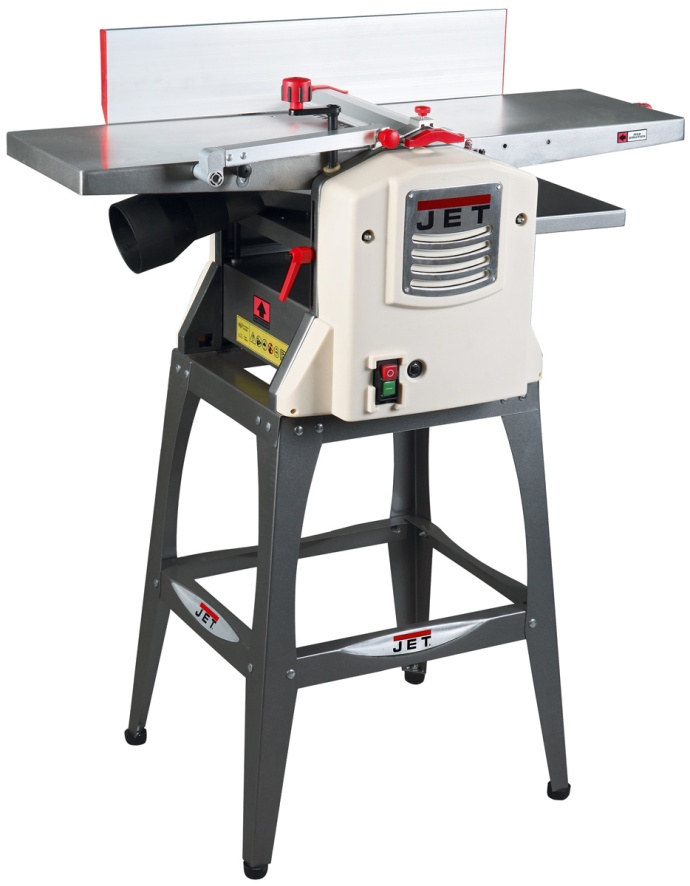
Among the equipment of the middle price category, it is difficult to find another universal machine with the same number of adjustments and similar accuracy. In addition, at the declared frequency of rotation of the planing shaft, the feed rate of the workpiece is quite low. But not so much that a 1.5 kW commutator motor could not cope with the automatic run of a board or beam. In general, this ratio has a positive effect on the quality of wood processing.
In light of such features, the engine temperature control system is perceived as a mandatory feature. And adjusting the depth of planing and the position of the jointer stop are not considered exceptional opportunities. Fixing the thicknessing table in a predetermined position successfully complements the widespread opinion about high-quality multifunctional equipment.
| Specifications | Values |
|---|---|
| power, kWt | 1.5 |
| Shaft speed, rpm | 9000 |
| Automatic feeding speed of the workpiece, m/min | 6 |
| Depth of planing (maximum / working), mm | 3 / 1 |
| Limiting dimensions of the blank for thickness gauge (H-height / B-width), mm | H-120, B-254 |
| Thickness table length (joiner), mm | 305 (965) |
| Design features | Thermal relay, mechanical system for fixing the planer table, electronics controls are placed on the side surface of the machine |
| Add. equipment | Top table cutterhead guard, bell housing with chip ejector adapter, wrench set, installation tool planer knife, hand stops for safe operation |
| Weight, kg | 34 |
| Development / production | Switzerland / Switzerland, China |
| Cost, rub. | 31500 |
Watch video review:
7. Hitachi p13f - 35390 rubles.
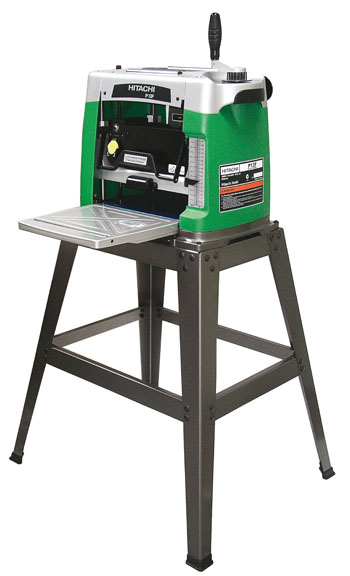
Precise adjustment of the depth of planing and the high speed of the two-knife shaft indicate that this model belongs to the number of prof. equipment. The working potential of which allows processing lumber for the production of furniture, windows, doors, all kinds of spatial structures and coverings from piece lumber.
The machine is equipped with an automatic feeding system. With the correct setting of the thickness gauge and suitable dimensions of the board (beam), there are no problems in operation. The task of the user is to bring the workpiece to the receiving roller and remove the planed part from the extended desktop extension.
The transmission of torque to the autofeed rollers is carried out through a gearbox. The thermal relay prevents wear of the power unit during operation with heavy loads. The start button protected by a cover does not allow to start the engine by accidental pressing. The installed chip removal cover will prevent the penetration of sawdust into the open cavities of the machine.
| Specifications | Values |
|---|---|
| power, kWt | 1.8 |
| Shaft speed, rpm | 9250 |
| Automatic feeding speed of the workpiece, m/min | 7.2 |
| Depth of planing (maximum / working), mm | 2.4 / 1 |
| Limit dimensions of the workpiece (H-height / B-width), mm | H-3.2-152.4 / B-330 |
| Design features | Retractable work table extensions, thermal protection, cutterhead locking lever, tool compartment, knife setting template |
| Add. equipment | Stand, hardware, set of keys |
| Weight with stand, kg | 46 |
| Development / production | Japan / Japan, USA, China |
| Cost, rub. | 35390 |
8. Makita 2012 NB - 40590 rubles.
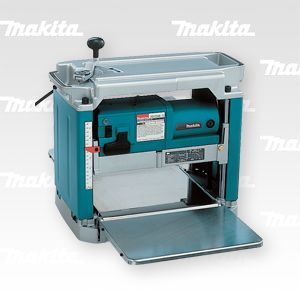
Professionals say that reducing the backlash of the working unit is possible only if a frame case and 4 guide racks are provided. In the 2012 NB model, possible misalignments are also leveled out by compression springs and steel balls at the base of the screws.
The double insulation of the motor makes it possible to work without connecting the machine to a ground loop. The rollers of the automatic feed system are covered with light rubber (therefore, when slipping, no marks are left on the workpiece). Due to the presence of springs at the junction of the platform and guides, the formation of a "step" at the edges of the workpiece is minimized.
Factory setting is accurate. It does not get lost either during transportation or after replacing the knives (only according to the template). And only after maintenance, this model requires the utmost attention when correcting the position of the guides.
| Specifications | Values |
|---|---|
| power, kWt | 1.65 |
| Shaft speed, rpm | 8500 |
| Automatic feeding speed of the workpiece, m/min | 8.5 |
| Depth of planing (maximum / working), mm | 3 / 1 |
| Limit dimensions of the workpiece (H-height / B-width), mm | H-155, B-304 |
| Thickness table length (joiner), mm | 771 |
| Design features | Double motor insulation, four-post planer block, compression springs and support balls at the base of the adjusting screw, minimum workpiece thickness limiter (3-100mm) |
| Add. equipment | Knife setting templates, wrench set, removable tool holder, chip nozzle |
| Weight, kg | 28.1 |
| Development / production | Japan / Japan, China |
| Cost, rub. | 40590 |
Watch video review Makita 2012 NB:
9. DeWalt 733 - 52243 rubles.
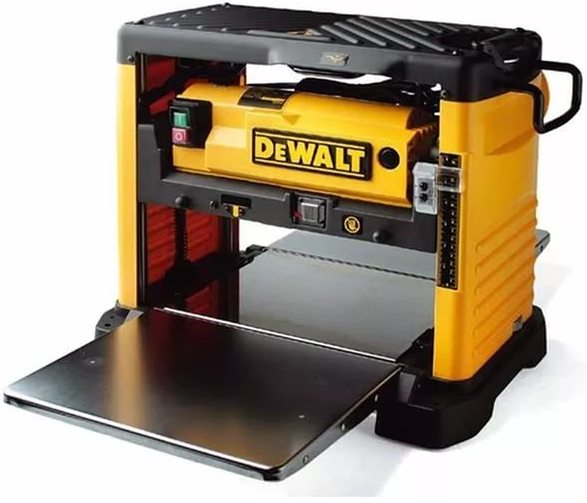
This model, designed for professional use, was developed by the manufacturer specifically for sale on the foreign market (American versions, marked "735" have 3 knives on the working shaft and are powered by a 120-volt network). And each implemented development definitely influenced general impression practicing professionals.
Hard blocking of the position of the planer block prevents any movement. Including under the influence of an uneven surface of the workpiece. Fine-tuning and planing depth limiter - ensure perfect sizing of the lumber. The automatic disconnector cuts off the power supply to the motor at the slightest increase in mains voltage. Reinforced frame, cast bed and securely fixed additional tables allow you to avoid marriage when working with long lengths.
| Specifications | Values |
|---|---|
| power, kWt | 1.8 |
| Shaft speed, rpm | 10000 |
| Automatic feeding speed of the workpiece, m/min | 8 |
| Depth of planing (maximum / working), mm | 2 / 1 |
| Limit dimensions of the workpiece (H-height / B-width), mm | H-152, B-317 |
| Thickness table length, mm | 520 |
| Design features | Guide posts pass through each corner of the working unit, fixing the cutterhead |
| Add. equipment | Wrench set, chip guard, vacuum cleaner adapter |
| Weight, kg | 33.6 |
| Development / production | USA / USA |
| Cost, rub. | 52243 |
Watch a video review of DeWalt 733:
10. Metabo HC 260 C WNB - 73,999 rubles.
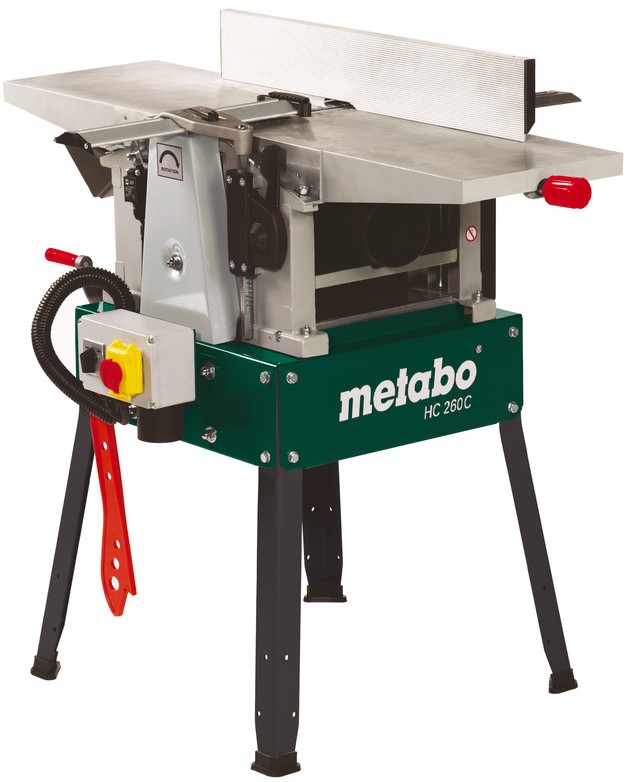
The impressive weight with small dimensions ensures sufficient stability of the HC 260 C WNB model. Among the highlights are a cast-iron planer table, an aluminum planer table with an adjustable stop, powerful engine and low rotational speed of the cutterhead.
The combination of these features indicates that universal machine to the category of professional equipment. That is, designed for intensive operation in conditions as close as possible to industrial ones.
Therefore, protection against motor overload is complemented by a set of measures to ensure safety. Among which are the blocking of the board during a reverse impact, and a magnetic starter (protection against voltage surges).
| Specifications | Values |
|---|---|
| power, kWt | 2.2 |
| Shaft speed, rpm | 6500 |
| Automatic feeding speed of the workpiece, m/min | 5 |
| Depth of planing (maximum / working), mm | 3 / 1 |
| Limiting dimensions of the blank for thickness gauge (H-height / B-width), mm | H-160 / B-260 |
| Thickness table length (joiner), mm | 400 (1040) |
| Design features | Cast iron planer table, magnetic start, accurate scale, claw catcher |
| Add. equipment | Chip removal cover, adapter pipe, pusher, set of keys, template for installing knives |
| Weight, kg | 71 |
| Development / production | Germany / Germany |
| Cost, rub. | 73999 |
Watch a short video review of the Metabo HC 260 C WNB:
Summary
With a properly tuned thickness gauge, you can count on a long machine life. Remove chips in a timely manner and perform maintenance on critical components. This will allow you to count on efficient work in the field of construction, within the walls of a creative workshop and at home.
The four-sided planer is used for simultaneous (in one pass) planing of the material from all four sides. In this case, the edges, and in a narrow material and the face, are often planed according to the shaped profile.
The machine has two horizontal knife shafts - lower and upper - with straight knives and two vertical spindles. Cutter heads with straight or shaped knives are mounted on the spindles. The lower knife shaft and vertical spindles are built into the bed and into the work plate. The upper knife shaft can be moved vertically to fit the material thickness, and the spindles can be moved vertically and horizontally according to the width and thickness of the material being processed, as well as tilted up to 25° to the horizontal axis.
The front part of the working plate of the machine is movable. Like u planer, it can be moved up and down to adjust the thickness of the layer of wood removed when planing.
The material is fed by means of two pairs of driven rolls, of which the upper rolls are corrugated, the array is hb1e. The machine is equipped with several clamps - top and side. The feed rolls and top hold-downs press the material either by their own weight or by means of weighted levers or springs.
Machine tools with five knife shafts are widely used. The fifth knife shaft, the last one in the direction of the material, is located at the bottom and serves for profile planing of the material from the underside.
The working shafts of the machine work from one common electric motor through a counter drive or from individual electric Engines. The total required power of the machine from 30 to 100 ket. Push-button control of the machine with individual motors.
Speed knife shafts 5000-6000 per minute. In machines latest designs knife shafts do up to 9000 rpm.
The feed rate in machines of the old design ranges from 8 to 22 m! min, v the latest machines it reaches 100 m/min And more. The feed rate is controlled by stepped pulleys or a gearbox.
The four-sided machine can be easily adapted for planing material only on three sides: for this, it is enough to turn off the lower knife shaft.
On a four-sided planer, the material, in most cases a board, is fed along the guides into the feed rollers and is pushed onto the lower knife roller. Here the lower face is cut off, as on a jointer. Against the knife shaft, a massive roller clamp presses on the board from above (Fig. 95).
With further advancement, the board passes two vertical spindles with flat or shaped knives mounted on them. With these tools, both edges of the board are processed according to a given profile. In front of the spindles, in close proximity to the cutting edges of the knives, there are two guides. In addition to their main purpose, they are used to support the fibers when planing edges and as chip breakers. Both guides can be moved horizontally along and across the table and set depending on the width of the processed boards and ra
cutting tool rotation radius on vertical spindles.
Behind the vertical spindles is the upper knife shaft, planing the upper surface of the board.
In the output part of the machine, the board is pushed onto the fifth knife shaft with shaped knives, if the lower face is processed under the profile.
The boards must be fed into the machine without breaks - end to end, since each new filling of the board under the heavy corrugated shaft requires considerable effort and additional time.
Of the four-sided planing machines of previous releases, the SKP 30-2 machine is still widely used. This machine has 5 knife shafts; the largest planing width on it is 300 mm, planing height - up to 175 mm; feed rate - from 9.5 to 48 m/min. The machine is electrified, its total power is 20.5 ket, weight 5500 kg.
At present, a new release machine is becoming more widespread - model SP30-1 (Fig. 96); technical specifications his daia in tab. 15. Sh
In addition to rotating knives, in order to obtain a cleaner planing (without waves), so-called ironing knives are installed on four-sided machines (Fig. 97). Purpose
|
Table 15
|
Ironing knives - to clean the crests of the waves formed by rotating knives. They are mounted motionless at a cutting angle of 45° in a special box, which, together with the knives, can be raised and lowered, depending on the thickness of the layer of wood intended to be cut off. The thinner the layer of wood cut by each knife, the cleaner the planed surface is. The thickness of the ironing
Bladed layer of wood - from 0.02 to 0.2 mm. On fig. 98 shows a diagram of the design of a modern four-sided planer equipped with ironing knives.
Currently, the machine tool industry produces the machines listed in Table. 15.
Each person may need emergency opening of locks, as there are many reasons due to which it is not possible to open the locking mechanism. Most often, people simply lose their keys or slam them inside the apartment, although ...
The door must have a set of reliable additional elements. Without such simple details as hinges and handles, the opening mechanism will not work. When buying various door accessories, you need to pay attention not only to ...
Lumber, or blanks, coming after cutting for further processing, as a rule, have risks, roughness, warping and other defects that are easily eliminated during planing.
When planing (along with the elimination of these defects), it is necessary to obtain an accurately adjusted (basic) surface so that, focusing on it, it is possible to align the rest of the surfaces and have parts of the correct shape.
A regular-shaped part is obtained if, during processing on a planer, it occupies a certain position in relation to the cutting tool and guides (table, ruler), while the accuracy of the part depends on how well the face and edge adjacent to the mounting devices are aligned (line). Planing usually results in smooth and profiled surfaces.
For planing, planer, planer and four-sided planers are used.
Purpose jointers - alignment of the surface of the part along the plane and into the corner. When planing on a planer, a base surface is created on the parts, which is necessary for their further processing on machines. Our industry produces planers with manual and mechanical feed. Machines with manual feed include jointers SF4-4 and SF-6; to machines with mechanical feed - double-sided planer S2F-4 with automatic feeding.
Jointers with manual feed are widely used in the production of joinery and can be recommended for enterprises with a small volume of production - up to 100-150 thousand m2 of joinery per year. At large volume production, jointing machines with mechanical feed should be used, as the most productive and safe in operation.
Planer with automatic feed, used for simultaneous planing of the face and edges of workpieces, is a cast-iron bed, on which, on eccentric supports, the front and rear plates of the desktop are located. Between the plates there is a horizontal knife shaft with a diameter of 125 mm, a length of 410 mm, rotating in ball bearings. The knife shaft is driven by an electric motor with a power of 2.8 kW through a V-belt transmission. There is a guide line on the plates.
Rice. 1. Scheme of a double-sided planer: 1 - fixed part of the ruler, 2 - fixing screw, 3 - bracket, 4 - rack, 5 - V-belt transmission, 6 - electric motor, 7 - screw adjusting the belt tension, 8 - plate for installing the electric motor, 9 - handle for mounting the bracket, 10 - eccentric for adjusting the installation of the movable part of the ruler, 11 - movable part of the ruler, 12 - cutter head, 13 - spindle
The size of the removed layer of wood is regulated by raising or lowering the front table with a handle with a height indicator. Adjustment of the position of the rear plate is made with a screw and a nut. In addition to the horizontal knife shaft, a vertical knife head is mounted on the machine, with which the edge of the workpiece is planed. The vertical cutter head is mounted on a spindle mounted on a special support. The drive of the spindle of the vertical cutter head is carried out from an electric motor with a power of 1.7 kW through a V-belt transmission.











How to understand: will the kitten be fluffy?
What kind of light alcohol can be drunk for pregnant women: the consequences of drinking
Why do the legs swell in the ankles and ankles of the feet in pregnant women: causes and methods of treatment
The wedding of Prince Harry and Meghan Markle: scandalous and secret details of the marriage (photo) The future marriage of Prince Harry year NTV
How to close white plums for the winter